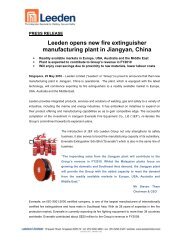Annual Report 2010 - Leeden Limited
Annual Report 2010 - Leeden Limited
Annual Report 2010 - Leeden Limited
Create successful ePaper yourself
Turn your PDF publications into a flip-book with our unique Google optimized e-Paper software.
Notes to the Financial Statementsfor the Financial Year ended 31 December <strong>2010</strong><strong>Leeden</strong> <strong>Limited</strong> <strong>Annual</strong> <strong>Report</strong> <strong>2010</strong>2. Summary of significant accounting policies (cont’d)2.7 Property, plant and equipmentAll items of property, plant and equipment are initially recorded at cost. Such cost includes the cost of replacing part ofthe property, plant and equipment and borrowing costs that are directly attributable to the acquisition, construction orproduction of a qualifying property, plant and equipment. The accounting policy for borrowing costs is set out in Note 2.26.The cost of an item of property, plant and equipment is recognised as an asset if, and only if, it is probable that futureeconomic benefits associated with the item will flow to the Group and the cost of the item can be measured reliably.Leasehold properties are subsequently stated at fair value, based on a one-off directors’ valuation in 1989, less subsequentdepreciation. These property, plant and equipment do not need to be revalued with sufficient regularity in accordance withparagraph 81(b) of FRS 16 (revised), Property, Plant and Equipment.Subsequent to recognition, property, plant and equipment are measured at cost or valuation less accumulated depreciationand accumulated impairment losses. When significant parts of property, plant and equipment are required to be replacedin intervals, the Group recognises such parts as individual assets with specific useful lives and depreciation, respectively.Likewise, when a major inspection is performed, its cost is recognised in the carrying amount of the plant and equipmentas a replacement if the recognition criteria are satisfied. All other repair and maintenance costs are recognised in profit orloss as incurred.Any revaluation surplus is recognised in other comprehensive income and accumulated in equity under the asset revaluationreserve, except to the extent that it reverses a revaluation decrease of the same asset previously recognised in profit orloss, in which case the increase is recognised in profit or loss. A revaluation deficit is recognised in profit or loss, exceptto the extent that it offsets an existing surplus on the same asset carried in the asset revaluation reserve.Any accumulated depreciation as at the revaluation date is eliminated against the gross carrying amount of the asset andthe net amount is restated to the revalued amount of the asset. The revaluation surplus included in the asset revaluationreserve in respect of an asset is transferred directly to retained earnings on retirement or disposal of the asset.Freehold land has an unlimited useful life and therefore is not depreciated.Depreciation is computed on a straight-line basis over the estimated useful lives of the assets as follows:Freehold property – 30 yearsLeasehold properties – over the term of the lease of 30 to 73½ yearsPlant and machinery – 6 months to 10 yearsOffice equipment, furniture and fittings – 3 to 10 yearsMotor vehicles – 5 to 8 yearsAssets under construction are not depreciated as these assets are not yet available for use.The carrying values of property, plant and equipment are reviewed for impairment when events or changes in circumstancesindicate that the carrying value may not be recoverable.The residual values, useful life and depreciation method are reviewed at each financial year-end to ensure that the amount,method and period of depreciation are consistent with previous estimates and the expected pattern of consumption of thefuture economic benefits embodied in the items of property, plant and equipment.An item of property, plant and equipment is derecognised upon disposal or when no future economic benefits are expectedfrom its use or disposal. Any gain or loss arising on derecognition of the asset is included in the income statement in theyear the asset is derecognised.2.8 Subsidiary companyA subsidiary company is an entity over which the Group has the power to govern the financial and operating policies so asto obtain benefits from its activities.In the Company’s separate financial statements, investments in subsidiary companies are accounted for at cost less anyimpairment losses.51





